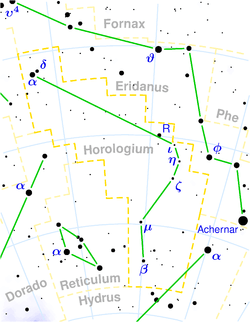R Horologii
 R Horologii (R) in Horologium | |
| Observation data Epoch J2000.0 Equinox J2000.0 | |
|---|---|
| Constellation | Horologium |
| Right ascension | 02h 53m 52.77206s[1] |
| Declination | −49° 53′ 22.7408″[1] |
| Apparent magnitude (V) | +3.92 |
| Characteristics | |
| Spectral type | M 5e–M 8eII/III |
| U−B color index | ? |
| B−V color index | ? |
| Variable type | Mira variable |
| Astrometry | |
| Radial velocity (Rv) | +60 ± 4.4 km/s |
| Proper motion (μ) | RA: 130.35 ± 0.74[1] mas/yr Dec.: 34.22 ± 0.72[1] mas/yr |
| Parallax (π) | 4.76 ± 0.97[1] mas |
| Distance | approx. 700 ly (approx. 210 pc) |
| Other designations | |
R Horologii (also known as HD 18242) is a red giant star approximately 700 light-years away in the constellation Horologium.[1] It is also a Mira variable with a period of 404.83 days,[3] and ranging from apparent magnitude 4.7 to 14.3—one of the largest ranges in brightness known.[4]
References
- 1 2 3 4 5 6 van Leeuwen, F. (2007). "Validation of the new Hipparcos reduction". Astronomy and Astrophysics. 474 (2): 653–64. arXiv:0708.1752
 . Bibcode:2007A&A...474..653V. doi:10.1051/0004-6361:20078357.
. Bibcode:2007A&A...474..653V. doi:10.1051/0004-6361:20078357. - ↑ "R Horologii". SIMBAD. Centre de données astronomiques de Strasbourg. Retrieved 18 March 2016.
- ↑ Templeton, M. R.; Mattei, J. A.; Willson, L. A. (2005). "Secular Evolution in Mira Variable Pulsations". The Astronomical Journal. 130 (2): 776. arXiv:astro-ph/0504527
 . Bibcode:2005AJ....130..776T. doi:10.1086/431740.
. Bibcode:2005AJ....130..776T. doi:10.1086/431740. - ↑ Privett, Grant; Jones, Kevin (2013). The Constellation Observing Atlas. New York, New York: Springer Science & Business Media. p. 102. ISBN 9781461476481.
External links
This article is issued from Wikipedia - version of the 3/19/2016. The text is available under the Creative Commons Attribution/Share Alike but additional terms may apply for the media files.